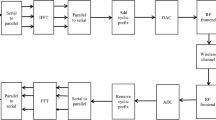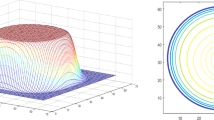Abstract
Polar codes are a class of block codes which are widely used in communication networks. Polar codes have been utilized in the fifth generation of enhanced mobile broadband systems (5G) due to their performance in error correction and also their low instinct complexity in implementation. However when they come in very large blocks, their efficient implementation in reasonable time is challenging. The automatic code generator (ACG) tools are useful and essential in these cases, when the design process should be error prone and time consuming. This paper presents an error prone and fast ACG tool to generate the VHDL description code at gate level for Polar decoders in multimedia communication systems according to user adjusted parameters including code-length, code-rate and quantization width, called PoCH tool. The PoCH constructs the Polar decoder using the design SNR and Bhattacharyya parameters which are set by the user, or are provided by a file consisting of the frozen bits location. The PoCH can generate the Polar decoder for four famous algorithms including SC, SSC, Fast-SSC and Fast-SSC + BiREP algorithms. To validate the performance of the PoCH tool, the block counts is presented for each generated code for various code-length, code-rate and Bhattacharyya parameters. Finally, the time consumed by the tool to generate Polar channel decoders for each algorithm is compared.






















Similar content being viewed by others
Data availability
The datasets generated during and/or analysed during the current study are not publicly available but are available from the corresponding author on reasonable request.
References
Arikan E (2009) Channel polarization: a method for constructing capacity-achieving codes for symmetric binary-input memoryless channels. IEEE Trans Inf Theory 55(7):3051–3073
Arıkan E (2011) System Polar Coding IEEE Commun Lett 15(1):860–862
Balatsoukas Stimming A K (2016) Hardware implementation aspects of polar decoders and ultra-highspeed LDPC decoders, PhD thesis, EPFL
Bioglio V, Condo C, Land I (2021) Design of Polar Codes in 5G new radio. IEEE Commun Surv Tutor 23(1):29–40
Chang, S-H, Tsai, M-L, Lee, M-H, Ho, J-M (2023) Optimal QoE Scheduling in MPEG-DASH Video Streaming. Int J Interact Multimed Artif Intell, In Press(In Press), 1–12
Chen K, Niu K, Lin J (2013) Improved successive cancellation decoding of polar codes. IEEE Trans Commun 61(8):3100–3107
CISCO White paper (2017) Cisco visual networking index: forecast and methodology. 2016–2021 CISCO VNI Report: 2011–2016
Condo C, Bioglio V, Hafermann H, Land I (2020) Practical product code construction of polar codes. IEEE Trans Signal Process 68(1):2004–2014
Doan N, Hashemi SA, Gross WJ (2022) Fast successive-cancellation list Flip decoding of polar codes. IEEE Access 10:5568–5584
Feng B, Jiao J, Wu S et al (2020) How to apply polar codes in high throughput space communications. Sci China Technol Sci 63:1371–1382
Giard P (2016) High-speed decoders for polar codes. PhD thesis. Department of Electrical and Computer Engineering, McGill University, Montreal
Giard P, Burg A (2018) Fast-SSC-flip decoding of polar codes. 2018 IEEE wireless communications and networking conference workshops (WCNCW), Barcelona: 73–77
Giard P, Balatsoukas-Stimming A, Sarkis G, Thibeault C, Gross WJ (2016) Fast low-complexity decoders for low-rate polar codes. Springer J Signal Process Syst 90:675–685
Gupta A, Ghanshala K, Joshi RC (2021) Machine learning classifier approach with Gaussian process, ensemble boosted trees, SVM, and linear regression for 5G signal coverage mapping. International journal of interactive multimedia and. Artif Intell 6(Regular Issue):156–163
Hamdan M K, Rover D T (2017) VHDL generator for a high performance convolutional neural network FPGA-based accelerator. 2017 international conference on ReConFigurable computing and FPGAs (ReConFig), Cancun: 1–6
Hashemi SA, Condo C, Mondelli M, Gross WJ (2019) Rate-flexible fast polar decoders. IEEE Trans Signal Process 67(22):5689–5701
İşcan O, Böhnke R, Xu W (2019) Probabilistic shaping using 5G new radio polar codes. IEEE Access 7:22579–22587
Kaykac Egilmez ZB, Xiang L, Maunder RG, Hanzo L (2020) The development, operation and performance of the 5G polar codes. IEEE Commun Surv Tutor 22(1):96–122
Kirchner A, Oetjens J, Bringmann O (2018) Using SysML for modelling and code generation for smart sensor ASICs. 2018 forum on Specification & Design Languages (FDL), Garching: 5–16
Kumar S, Kumar-Solanki V, Choudhary SK, Selamat A, González-Crespo R (2020) Comparative study on ant Colony optimization (ACO) and K-means clustering approaches for jobs scheduling and energy optimization model in internet of things (IoT). Int J Interact Multimed Artif Intell 6(Special Issue on Soft Computing):107–116
Leroux C, Raymond AJ, Sarkis G, Gross WJ (2013) A semi-parallel successive-cancellation decoder for polar codes. IEEE Trans Signal Process 61(2):289–299
Li S, Deng Y, Lu L, Liu J, Huang T (2018) A low-latency simplified successive cancellation decoder for polar codes based on node error probability. IEEE Commun Lett 22(12):2439–2442
Li Z, Miao M, Wang Z (2020) Parallel coding scheme with Turbo product code for Mobile multimedia transmission in MIMO-FBMC system. IEEE Access 8:3772–3780
Lin J, Xiong C, Yan Z (2016) A high throughput list decoder architecture for polar codes. IEEE Trans Very Large Scale Integration (VLSI) Syst 24(6):2378–2391
Mahmood OF, Jasim IB, Qasim NH (2021) Performance enhancement of Underwater Channel using polar code-OFDM paradigm. Int Res J Modernization Eng Technol Sci 3(9):55–62
McEliece R (2003) The theory of information and coding. Cambridge University Press
Möller K, Kumm M, Kleinlein M, Zipf P (2017) Reconfigurable constant multiplication for FPGAs. IEEE Trans Comput-Aided Des Integr Circ Syst 36(6):927–937
Núñez-Valdez E, Solanki VK, Balakrishna S, Thirumaran M (2020) Incremental hierarchical clustering driven automatic annotations for unifying IoT streaming data. Int J Interact Multimed Artif Intell 6(Regular Issue):15
Oliveira RM, De Lamare RC (2021) Design of Rate-Compatible Polar Codes Based on non-Uniform Channel polarization. IEEE Access 9:41902–41912
Özkan MA et al (2020) AnyHLS: high-level synthesis with partial evaluation. IEEE Trans Comput-Aided Des Integr Circ Syst 39(11):3202–3214
Pinto-Santos, F, Alizadeh-Sani, Z, Alonso-Moro, D, González-Briones, A, Chamoso, P, Corchado, JM (2021) A template-based approach to code generation within an agent paradigm. In: Highlights in practical applications of agents, multi-agent systems, and social good. The PAAMS collection. PAAMS 2021. Communications in Computer and Information Science, vol 1472. Springer
Polyanskiy Y (2010) Channel coding: non-asymptotic fundamental limits. PhD thesis, Deptatment of Electrical Engineering, Princeton University
Säily M et al (2020) 5G radio access network architecture for terrestrial broadcast services. IEEE Trans Broadcast 66(2):404–415
Şaşoğlu E, Wang L (2014) Universal polarization. IEEE international symposium on information theory (ISIT), Honolulu: 1456–1460
Shannon CE (1948) A mathematical theory of communication. Bell Syst Tech J 27(3):379–423
Shariat M, et al. (2019) A flexible network architecture for 5G systems. Wirel Commun Mob Comput, 2019: 19 pages
Su Z et al (2021) Code synthesis for dataflow-based embedded software design. IEEE Trans Comput-Aided Des Integr Circ Syst 41(1):49–61
Szczęsny S (2018) HDL-based synthesis system with debugger for current-mode FPAA. IEEE Trans Comput-Aided Des Integr Circ Syst 37(5):915–926
Takamaeda-Yamazaki S (2015) Pyverilog: A Python-Based Hardware Design Processing Toolkit for Verilog HDL. In: Sano K, Soudris D, Hübner M, Diniz P (eds) Applied Reconfigurable Computing. ARC 2015. Lecture notes in computer science, 9040. Springer, Cham
Trost A, Žemva A (2019) Online VHDL Generator and Analysis Tool. 2019 8th Mediterranean conference on embedded computing (MECO), Budva, Montenegro: 1–4
Xu Y, Zhang H, Chen Y, Liu F (2021) Basic model study of automatic generation method. ICMLCA 2021, 2nd international conference on machine learning and computer application: 1-5
Zeng J, Zhou Y, Lin J, Wang Z (2019) Hardware Implementation of Improved Fast-SSC-Flip Decoder for Polar Codes. 2019 IEEE computer society annual symposium on VLSI (ISVLSI), Miami, FL, USA: 580–585
Zhang X, Zhu Q (2018) Scalable virtualization and offloading-based software-defined architecture for heterogeneous statistical QoS provisioning over 5G multimedia Mobile wireless networks. IEEE J Select Areas Commun 36(12):2787–2804
Zhang X, Yan X, Zeng Q, Cui J, Cao N, Higgs R (2018) high-throughput fast-SSC polar decoder for wireless communications. Wirel Commun Mob Comput, 2018: 10 pages
Acknowledgements
This work was supported by Shahid Chamran University of Ahvaz under Grant Number SCU.EE99.256.
Author information
Authors and Affiliations
Corresponding author
Ethics declarations
Conflict of interest
The authors declare that they have no known competing financial interests or personal relationships that could have appeared to influence the work reported in this paper.
Additional information
Publisher’s note
Springer Nature remains neutral with regard to jurisdictional claims in published maps and institutional affiliations.
Rights and permissions
Springer Nature or its licensor (e.g. a society or other partner) holds exclusive rights to this article under a publishing agreement with the author(s) or other rightsholder(s); author self-archiving of the accepted manuscript version of this article is solely governed by the terms of such publishing agreement and applicable law.
About this article
Cite this article
Hematkhah, H., Kavian, Y. & Namjoo, E. PoCH: automatic HDL code generator tool for Polar channel coding decoders in multimedia communication systems. Multimed Tools Appl 82, 36739–36768 (2023). https://doi.org/10.1007/s11042-023-14507-w
Received:
Revised:
Accepted:
Published:
Issue Date:
DOI: https://doi.org/10.1007/s11042-023-14507-w




